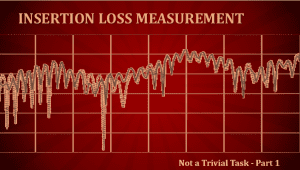Here at Fiber Optic Center, we are asked questions daily about insertion loss measurement. It might seem like a trivial task to make an insertion loss measurement on a fiber optic connector but it’s not – it is impossible.
Only the loss of a connection can be measured, a mated pair of connectors. What this means is that to qualify the performance of a Jumper, other cables are required and the quality of these affects the number we get for our DUT. One possible way out would be to loop the jumper and connect it to itself, cut it in half and splice to the measurement system. This might be useful for product development and perhaps batch testing, but it’s hardly practical as a production tool.
So, when the normal method is used, with a referenced launch jumper, any loss measured for and attributed to) a DUT connector comes from a combination of defects in and mismatches between the DUT and launch connectors. So, should the launch jumper should be perfect?

Some say it should be a “typical” jumper of the same type as the DUT to be more representative of the real world situation, but that’s like showing the effects of cosmetics on “typical” folks rather than good looking models. You want to show your product at its best.
Referencing the launch jumper measures the power of the light flooding out of the connector, without much regard for direction or diffusion, this is not necessarily the power of the light injected into the core of the DUT connector. Obviously scratches and other defects are to be avoided, but a significant component of IL in a connection is offset between the cores, if two connectors with offsets in different directions are mated there will be significant loss. If this offset& just happens to be in the same for launch jumper and DUT, the loss might be quite low. I would have to say that choosing a test jumper to match a systematic error in the DUT would be a bit naughty. So, for me the best solution would be to use a “perfect” launch jumper, so that all aspects of IL can be attributed to the DUT – without argument.
No such thing as perfect, so how good is good enough? You could use reference quality jumpers, but this would be prohibitively expensive,$4.99 jumpers of unknown origin are probably not a good idea either. I cannot, without leaving some company out, (probably a FOC customer) make a definitive recommendation, but good quality jumpers from an established 1st tier manufacturer should be fine. I would say that for a new production facility, making your own launch jumpers might be a bad idea, at least initially. Launch jumpers should use the same fiber type, not just the same size, we have seen problems mating bend insensitive fiber to the regular type. For Multi-Mode, use test jumpers built with single mode connector hardware.



